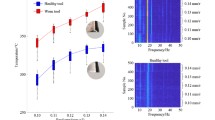Abstract
Tool wear, chatter vibration, chip breaking and built-up edge are the main phenomena to be monitored in modern manufacturing processes. Much work has been carried out in the analysis and detection of these phenomena. However, most work has been mainly concerned with single, isolated detection of such phenomena. The relationships between each fault have so far received very little attention. This paper presents a neural-network-based on-line fault diagnosis scheme which monitors the level of tool wear, chatter vibration and chip breaking in a turning operation. The experimental results show that the neural network has a high prediction success rate.
Similar content being viewed by others
References
U. Uehara and Y. Kanda, “Identification of chip formation mechanism through acoustic emission measurements”,Annals of CIRP,33(1), pp. 71–74, 1984.
L. I. Burke and S. Rangwala, “Tool condition monitoring in metal cutting: a neural network approach”,Journal of Intelligent Manufacturing,2, pp. 269–280, 1991.
D. A. Dornfeld, “Neural network sensor fusion for tool condition monitoring”,Annals of the CIRP,39(1), pp. 101–105, 1990.
J. Rotberg, A. Ber and R. Wertheim, “Chip control in cut-off tools”,Annals of the CIRP,40(1), pp. 73–77, 1991.
Eui-Sik CHUNG, Suk NAMGUNG and Yoshimi ITO, “In-process recognition of chip forms using dynamic component of cutting force”,Proceedings of JSME,55(518), Part C, pp. 2632–2636, 1989.
S. Rangwala and D. A. Dornfeld, “Sensor integration using neural networks for intelligent tool condition monitoring”,Transactions of the ASME, Journal of Engineering Industry,112, pp. 219–228, 1990.
Toshimichi Moriwaki and Yoshinobu Mori, “Recognition of cutting state based on neural network sensor fusion”,JSPE,59(5), pp. 779–784, 1993.
I. E. Minis, E. B. Magrab and I. O. Pandelidis, “Improved methods for the prediction of chatter in turning”,Transactions of the ASME, Journal of Engineering for Industry,112, pp. 12–35, 1990.
T. Delio, J. Tlusty and S. Smith, “Use of audio signals for chatter detection and control”,Transactions of the ASME, Journal of Engineering for Industry,114, pp. 146–157, 1992.
K. Jemielniak and A. Widota, “The development of frequency and amplitude of chatter vibration”,International Journal of Machine Tools and Manufacturing,29, pp. 249–256, 1989.
D. E. Rumelhart and J. L. McClelland,Parallel Distributed Processing, vol. 1, MIT Press, 1986.
Author information
Authors and Affiliations
Rights and permissions
About this article
Cite this article
Rahman, M., Zhou, Q. & Hong, G.S. On-line cutting state recognition in turning Using a neural network. Int J Adv Manuf Technol 10, 87–92 (1995). https://doi.org/10.1007/BF01179276
Issue Date:
DOI: https://doi.org/10.1007/BF01179276




